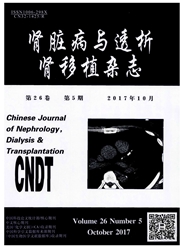

 中文摘要:
中文摘要:
目的:分析南京总医院国家肾脏疾病临床医学研究中心血液透析患者首次和目前血管通路使用情况及影响因素。方法:将2015年7月~2015年12月间在院行维持性血液透析治疗的患者纳入研究。结果:294例患者,男性189例(64.3%),女性105例(35.7%),年龄53.2±15.1岁(15~87岁),透析龄6.2年(0.3~32)年。首次透析血管通路为动静脉内瘘56例(19.0%),无涤纶套导管235例(79.9%)。维持性血液透析患者血管通路动静脉内瘘占91.8%,带隧道带涤纶套导管占6.1%。年龄〉65岁患者动静脉内瘘使用率开始减少,导管使用率增加。无涤纶套导管置管部位主要以颈内静脉为主,感染发生率为0.52/1 000导管日。自体动静脉内瘘部位主要以左桡动脉-头静脉为主(75.4%),早期并发症主要是术后血栓形成,晚期并发症包括内瘘堵塞、动脉瘤样扩张/动脉瘤形成及肢体水肿等。结论:首次血液透析时血管通路以无涤纶套导管为主,维持性血液透析阶段血管通路以动静脉内瘘为主。导管置管部位主要以颈内静脉为主,且感染发生率较低。动静脉内瘘部位以左侧桡动脉-头静脉为主,早期并发症主要是术后血栓形成,晚期并发症包括内瘘堵塞、动脉瘤样扩张/动脉瘤形成及肢体水肿等。
 英文摘要:
英文摘要:
Objective:To analyze the vascular access and its complications in hemodialysis(HD) patients in our center. Methodology: Patients receiving maintence hemodialysis therapy in our center were included in this study.Results:294 patients were enrolled in our study including 189 males(64. 3%) and 105 females(35. 7%) aged 53. 2 ±15. 1 years,and their dialysis duration was 0. 3 to 32 years.Initial access was non-cuffed temporary catheters in 235 patients(79. 9%) and arteriovenous fistula(AVF) in 56 patients(19. 0%). As to vascular access in maintenance hemodialysis stage,the use rate of AVF in patients with HD was 91. 8% and tunneled cuffed catheter was 6. 1%. Central venous access was preferentially obtained in the internal jugular vein,and the result of catheter-related infections was 0. 52/1 000 catheter days in non-cuffed temporary catheters. The main creation site of AVF is radio-cephalic fistula(75. 4%). Conclusion:In this cross-sectional study,we found the initial vascular access was mainly non-cuffed temporary catheter,and the mainly use of vascular access is AVF at present. Central venous access is preferentially obtained in the internal jugular vein and has a low rate of catheter-related infections. The main creation site of AVF is radio-cephalic fistula.
 同期刊论文项目
同期刊论文项目
 同项目期刊论文
同项目期刊论文
 期刊信息
期刊信息
